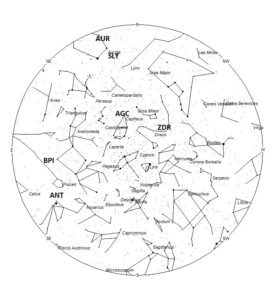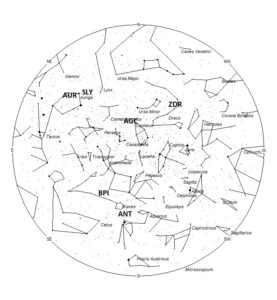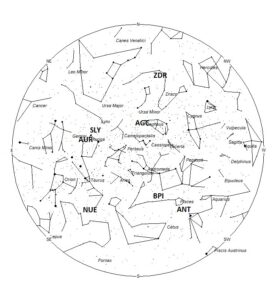September offers longer nights in the northern hemisphere that tend to be less hazy than those experienced in mid-summer. In the sky, no major showers are visible from either hemisphere, but the northern hemisphere enjoys the advantage of higher sporadic rates. Most of the shower activity this month is produced from the Perseus-Aurigid complex active this time of year. These showers rarely produce more than 5 meteors per hour but still manage to produce most of the shower activity seen this month. Unfortunately, the Perseus-Aurigid complex lies too low in the northern sky for southern hemisphere observers to view very well. Video studies have shown that the Taurids are visible as early as September 28th, therefore after this date the Anthelion radiant will no longer be listed until the Taurid showers end in December. The Anthelion meteors are still active but their radiant is superimposed upon that of the more numerous Taurids, therefore it is impossible to properly separate these meteors. Observers in the southern hemisphere suffer from some of their lowest rates of the year this month. The Taurid radiants are not too badly placed so observers south of the equator can expect to see a little of this activity from this source this month.
During this period, the moon reaches its new phase on Tuesday September 3rd. At that time the moon will lie near the sun in the sky and will be invisible at night. This weekend the waning crescent moon will not interfere with meteor observing as it will be too thin and will rise shortly before dawn. The estimated total hourly rates for evening observers this weekend should be near 4 as seen from mid-northern latitudes (45N) and 3 as seen from tropical southern locations (25S) For morning observers, the estimated total hourly rates should be near 16 as seen from mid-northern latitudes (45N) and 10 as seen from tropical southern locations (25S). The actual rates seen will also depend on factors such as personal light and motion perception, local weather conditions, alertness, and experience in watching meteor activity. Note that the hourly rates listed below are estimates as viewed from dark sky sites away from urban light sources. Observers viewing from urban areas will see less activity as only the brighter meteors will be visible from such locations.
The radiant (the area of the sky where meteors appear to shoot from) positions and rates listed below are exact for Saturday night/Sunday morning August 31/September 1. These positions do not change greatly day to day so the listed coordinates may be used during this entire period. Most star atlases (available at science stores and planetariums) will provide maps with grid lines of the celestial coordinates so that you may find out exactly where these positions are located in the sky. I have also included charts of the sky that display the radiant positions for evening, midnight, and morning. The center of each chart is the sky directly overhead at the appropriate hour. These charts are oriented for facing south but can be used for any direction by rotating the charts to the desired direction. A planisphere or computer planetarium program is also useful in showing the sky at any time of night on any date of the year. Activity from each radiant is best seen when it is positioned highest in the sky, either due north or south along the meridian, depending on your latitude. Radiants that rise after midnight will not reach their highest point in the sky until daylight. For these radiants, it is best to view them during the last few hours before dawn. It must be remembered that meteor activity is rarely seen at its radiant position. Rather they shoot outwards from the radiant, so it is best to center your field of view so that the radiant lies toward the edge and not the center. Viewing there will allow you to easily trace the path of each meteor back to the radiant (if it is a shower member) or in another direction if it is sporadic. Meteor activity is not seen from radiants that are located far below the horizon. The positions below are listed in a west to east manner in order of right ascension (celestial longitude). The positions listed first are located further west therefore are accessible earlier in the night while those listed further down the list rise later in the night.

Radiant Positions at 22:00 LST

Radiant Positions at 01:00 LST

Radiant Positions at 04:00 LST
These sources of meteoric activity are expected to be active this week
.
The zeta Draconids (ZDR) were discovered by Zdenek Sekanina in his study of meteor streams using radio methods. This stream is active from August 12-September 5 with maximum activity occurring on August 26. The radiant is currently located at 16:09 (242) +60, which places it in southeastern Draco, 2 degrees northeast of the 3rd magnitude star known as theta Draconis. This radiant is best placed near 1900 Local Summer Time (LST), when it lies on the meridian and is located highest in the northern sky. With an entry velocity of 20 km/sec., the average zeta Draconid meteor would be of slow velocity. Rates this week are expected to be less than 1 no matter your location. Due to the high northern declination these meteors are difficult to observe from the southern hemisphere. These meteors are synonymous with the August Draconids (AUD).
The large Anthelion (ANT) radiant is currently centered at 23:24 (351) -04. This position lies in central Aquarius, 4 degrees northeast of the 4th magnitude star known as phi Aquarii. This location is also 5 degrees north of the first magnitude planet Saturn. This radiant is best placed near 02:00 LST when it lies on the meridian and is highest in the southern sky. Rates at this time should be near 3 per hour as seen from the northern hemisphere and 3 as seen from south of the equator. With an entry velocity of 30 km/sec., the average Anthelion meteor would be of medium-slow velocity.
The August gamma Cepheids (AGC) are a recent discovery by Damir Šegon and the Croatian Meteor Network team based on studying SonotaCo and CMN observations (SonotaCo 2007-2011, CMN 2007-2010). Meteors from this source are expected from August 17 through September 6, with maximum activity occurring on August 29. The current position lies at 23:56 (359) +78, which lies in northern Cepheus, 1 degree northeast of the 3rd magnitude star known as Errai (gamma Cephei A). To best see these meteors, face toward the north near 0300 LST, when it lies on the meridian and is located highest in the northern sky. Rates at this time should be less than 1 per hour no matter your location. With an entry velocity of 44 km/sec., the average meteor would be of medium velocity. These meteors are not generally visible south of latitude 10 South.
The August beta Piscids (BPI) are part of the Northern delta Aquariid complex, active from August 18-September 8. This second peak of the NDA’s occurs on August 20th, when the radiant lies well within the boundaries of the constellation of Pisces. The radiant currently is located near 00:05 (001) +09. This area of the sky is located in central Pisces, 3 degrees northeast of the 4th magnitude star known as omega Piscium. To best see these meteors, look toward the south near 0300 LST, when it lies on the meridian and is located highest in the northern sky. Hourly rates at this time should be less than 1 no matter your location. With an entry velocity of 37 km/sec., the average meteor from this source would be of medium velocity.
The September epsilon Perseids (SPE) are active from September 2-23, with maximum activity occurring on the 9th. The current position of the radiant lies at 02:33 (038) +39. This area of the sky lies in eastern Andromeda, 6 degrees southwest of the famous eclipsing variable star known as Algol (beta Persei). To best see these meteors, face half-way up toward the northeast during the last hour prior to dawn. Rates at this time may be near 1 per hour as seen from the northern hemisphere and less than 1 as seen from south of the equator. There have been outbursts from this source in the past, but none are predicted for this year. With an entry velocity of 64 km/sec., the average meteor would be of swift velocity.
The nu Eridanids (NUE) were co-discovered by Japanese observers using SonotoCo and Jürgen Rendtel and Sirko Molau of the IMO. Activity from this source stretches from August 31 to September 21. The main maximum activity occurs on September 10th. A secondary maximum occurs on September 16th. The radiant currently lies at 04:03 (061) -03, which places it in northeastern Eridanus, 6 degrees northwest of the 4th magnitude star known as mu Eridani. Observers concentrating on this activity should face toward the southeastern sky during the last dark hour prior to dawn to best view these meteors. Current rates are expected to be less than 1 per hour during this period no matter your location. With an entry velocity of 65 km/sec., the average meteor from this source would be of swift velocity.
The September Lyncids (SLY) are active from August 30th through September 20th with maximum activity occurring on September 10th. The radiant is located at 06:05 (091) +54, This position lies in northern Auriga, 2 degrees southeast of the 4th magnitude star known as delta Aurigae. To best see these meteors, view half-way up in the northeastern sky during the last hour prior to dawn. Rates are expected to be less than 1 per hour. With an entry velocity of 61 km/sec., the average meteor from this source would be of swift velocity. The meteors are not readily visible from the southern hemisphere as the radiant does not rise high enough before the onset of dawn.
The Aurigids (AUR) are active from August 26 through September 4, peaking on August 31st. The radiant is currently located at 06:07 (092) +39. This position lies in central Auriga, 2 degrees north of the 3rd magnitude star known as Mahasim (theta Aurigae A). To best see these meteors, it is suggested to view toward the northeastern sky during the last hour prior to dawn. Normally, hourly rates are less than 1 except on the night of maximum activity. With an entry velocity of 65 km/sec., the average meteor from this source would be of swift velocity.
Sporadic meteors are those meteors that cannot be associated with any known meteor shower. All meteor showers are evolving and disperse over time to the point where they are no longer recognizable. Away from the peaks of the major annual showers, these sporadic meteors make up the bulk of the activity seen each night. As seen from the mid-northern hemisphere (45N) one would expect to see during this period approximately 12 sporadic meteors per hour during the last hour before dawn as seen from rural observing sites. Evening rates would be near 3 per hour. As seen from the tropical southern latitudes (25S), morning rates would be near 7 per hour as seen from rural observing sites and 2 per hour during the evening hours. Locations between these two extremes would see activity between these listed figures.
The list below offers the information in tabular form of the showers that I feel are within reach of the visual observer to discern. Hourly rates are often less than one, so these sources are rarely listed as visual targets in most meteor shower lists. If you are like me and wish to associate as many meteors as possible with known sources, then you will appreciate these listings. Before listing meteors from these obscure sources, you should attempt to prove these meteors belong to them and are not chance alignments of sporadic meteors. You can note parameters such as duration, length, radiant distance and the elevation of each meteor to help compute the probability of shower association. It should be remembered that slow meteors can be seen from fast showers, but fast meteors cannot be produced from slow showers. Slower showers are those with velocities less than 35/km per second. Slow meteors can appear from fast showers when they appear close to the radiant or low in the sky. The table located on page 22 of the IMO’s 2024 Meteor Shower Calendar is a big help in aiding in the identification of meteors. If you record the length and duration of each meteor, you can use this chart to check the probability of the meteor belonging to a shower of known velocity. If the angular velocity is similar to the figure in the table, then your meteor probably belongs to that shower. Rates and positions are exact for Saturday night/Sunday morning.
| SHOWER | DATE OF MAXIMUM ACTIVITY | CELESTIAL POSITION | ENTRY VELOCITY | CULMINATION | HOURLY RATE | CLASS |
| RA (RA in Deg.) DEC | Km/Sec | Local Summer Time | North-South | |||
| zeta Draconids (ZDR) | Aug 26 | 16:09 (242) +60 | 20 | 19:00 | <1 – <1 | IV |
| Anthelions (ANT) | – | 23:24 (351) -04 | 30 | 02:00 | 3 – 3 | II |
| August gamma Cepheids (AGC) | Aug 28 | 23:56 (359) +78 | 44 | 03:00 | <1 – <1 | IV |
| August beta Piscids (BPI) | Aug 21 | 00:05 (001) +09 | 37 | 03:00 | <1 – <1 | IV |
| September epsilon Perseids (SPE) | Sep 09 | 02:33 (038) +39 | 64 | 05:00 | <1 – <1 | II |
| nu Eridanids (NUE) | Sep 10 | 04:03 (061) -03 | 65 | 07:00 | <1 – <1 | II |
| September Lyncids (SLY) | Sep 10 | 06:05 (091) +54 | 61 | 09:00 | <1 – <1 | IV |
| Aurigids (AUR) | Aug 31 | 06:07 (092) +39 | 65 | 09:00 | 1 – <1 | II |
You can keep track of the activity of these meteor showers as well as those beyond the limits of visual observing by visiting the NASA Meteor Shower Portal. You can move the sky globe to see different areas of the sky. Colored dots indicate shower meteors while white dots indicate sporadic (random) activity. The large orange disk indicates the position of the sun so little activity will be seen in that area of the sky.
Class Explanation: A scale to group meteor showers by their intensity:
- Class I: the strongest annual showers with Zenith Hourly Rates normally ten or better.
- Class II: reliable minor showers with ZHR’s normally two to ten.
- Class III: showers that do not provide annual activity. These showers are rarely active yet have the potential to produce a major display on occasion.
- Class IV: weak minor showers with ZHR’s rarely exceeding two. The study of these showers is best left to experienced observers who use plotting and angular velocity estimates to determine shower association. These weak showers are also good targets for video and photographic work. Observers with less experience are urged to limit their shower associations to showers with a rating of I to III.

